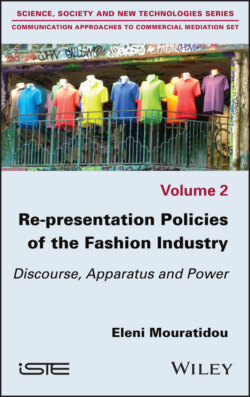Читать книгу Re-presentation Policies of the Fashion Industry - Eleni Mouratidou - Страница 12
I.4. Counterfeits and beliefs
ОглавлениеFirst of all, let us specify that in the framework of re-presentation policies linked to the fashion industry, it is not a matter of questioning the authentic dimension of the marketed products19, to which I do not grant any artistic value from the start. Fashion industry products “appeal to creativity in the design phase [but] are also backed by the heritage they reproduce and even extend, being preserved for exchange and sale” (Miège 2017, p. 94, author’s translation), which is not the case for artistic creative activity20. While the couturier’s fashion gesture may result in creations whose esthetic qualities can in some cases be recognized, this same gesture is not detached from a production perspective and commercial offer that inevitably determines the creation, itself no longer being, as stated above, the result of a single person but of a team contributing to the creative management of the product and its brand. The artistic positioning that accompanies the fashion industry’s products must also be related to “the objective of designers who implement avant-garde strategies [and which] is not to attain the status of an artist but rather to acquire a form of symbolic capital that enhances the fashion designer’s status” (Crane 2012, p. 248, author’s translation). At the same time, with the luxury fashion market being particularly developed and even industrialized, its professionals “know or should know that the realities of the markets in which the brands or houses they represent are present have little to do with the rarity, inaccessibility, and sometimes even absolute perfection of the object” (Bertrand 2011, p. 319, author’s translation). Faced with this constraint that opposes luxury and the market, I will question the counterfeit posture of the players in the fashion industry in the design of their re-presentation policies.
“A forgery of a work of art is an object falsely purporting to have the history of production requisite for the (or an) original of the work” (Goodman 1976, p. 122). Based on this premise, it is possible to consider counterfeiting as the process of falsely endowing an object with a certain authenticity. Authenticity also plays a key role in the discourse and strategies of those involved in the sector. Faced with what Abélès (2018a, p. 92) describes as a “logo fatigue”, the argument of authenticity becomes a communication necessity. However, it is based on illusionist discourse about the historical and symbolic depth that accompanies the goods and the communication strategies of commercial luxury. By questioning the counterfeit position of the fashion industry’s re-presentation policies, the aim is to account for the way in which discourses that are commonplace, such as art and culture, the sacred and religion as well as politics, present themselves as an excellent communicational pre-text and pretext granting the actors of this industry a self-referential legitimacy. It is also a question of accounting for the way in which, just as fashion is copied and counterfeited, art and culture, the sacred, religion and politics can be copied and also counterfeited, probably because of their polychresic21 dimension.
However, this communicational counterfeiting is motivated by a goal of persuasion, efficiency and belief. This is how spectacular density comes into play, by erasing the fiction, the rigged, the fabricated and by offering what marketing professionals call an experience. Here is Guy Debord’s introductory reference to his book The Society of the Spectacle, quoting the German philosopher Feurerbach:
and without doubt our epoch…prefers the image to the thing, the copy to the original, the representation to the reality, appearance to being…what is sacred for it is only illusion, but what is profane…is truth. More than that, the sacred grows in its eyes to the extent that truth diminishes and illusion increases, to such an extent that the peak of illusion is for the peak of the sacred. (Debord 1987)
The fashion industry’s re-presentational policies, such as certain advertising campaigns, museum exhibitions or commercial scenography, are organized as a smooth, controlled spectacle to make people see and believe. As historian Daniel J. Boorstin points out, “the most effective images are usually those which have been especially doctored for believability” (Boorstin 1961, p. 188). The regimes of showing and make-believe instituted by the fashion industry’s re-presentational policies are no longer constructed, like the theatrical convention, as a process of illusion in which we want to believe because we have agreed to put ourselves in the position of spectators adhering to that convention. Re-presentation is an admission of the concealment of the merchandise and the promotional methods that go with it. “This concealment is not the lie that should be pierced through [it is] its way of telling the truth about the concealment that constitutes it” (Rancière 2017, p. 66, author’s translation). What is happening in the framework of the fashion industry’s re-presentation policies is a belief system that is no longer a matter of making people see and make them believe, but of seeing and believing. Belief becomes an assertion because it is manipulated by the re-presentational device, its mechanisms of orientation and modeling. It offers itself to be seen as a presence and tends to minimize, even erase, its re-presentational discourses (Boorstin 1962, p. 249). It densifies its mythological dimension because it introduces fashion into its system as a presence “rendered as transparent” (Barthes 2002, p. 832, author’s translation). The appearance of merchandise and promotional strategies is not an “illusion to be crossed to discover the truth, it is the phantasmagoria that testifies to the truth of a metamorphic process” (Rancière 2017, p. 66, author’s translation), a process that describes and even troubles the fashion industry and to which the latter must respond through its re-presentational policies.
